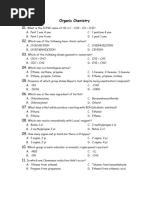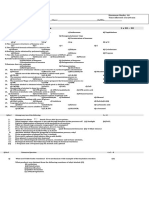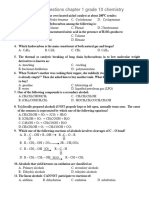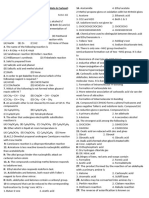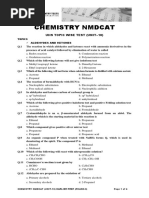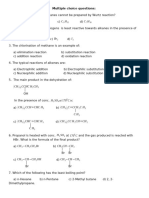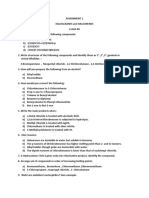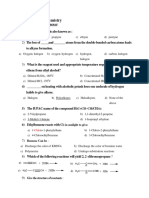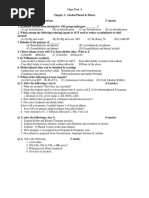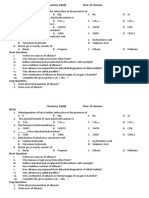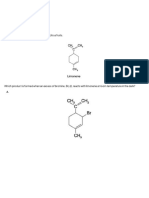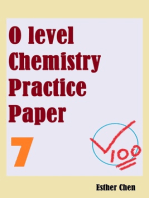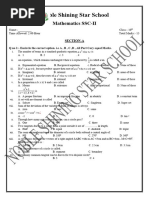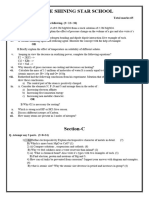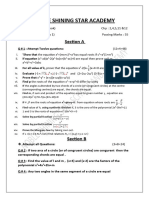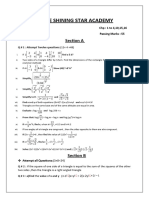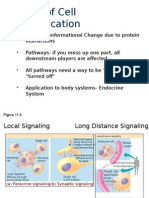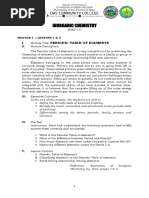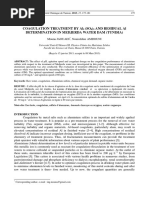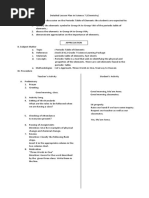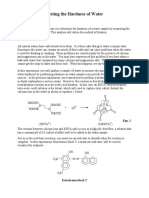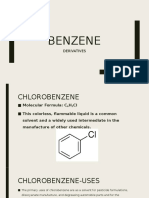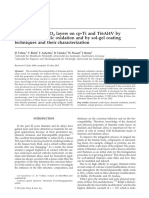0 ratings0% found this document useful (0 votes)
17 views10th CHM
10th CHM
Uploaded by
zeeshanhameedz1996This document provides information about a chemistry exam including:
1) Section A contains 10 multiple choice questions testing knowledge of processes like dehydrogenation, compounds like ethylene glycol and ethane, and properties of alcohols, alkenes, and alkynes.
2) Section B contains 6 short answer questions asking about differentiating compounds, drawing structures, and preparing ethyne from vicinal dihalides.
3) Section C contains 5 short answer questions about bromine water tests, converting ethyne to oxalic acid, and drawing a flowchart for classifying organic compounds. The exam is 45 minutes with 30 points needed to pass.
Copyright:
© All Rights Reserved
Available Formats
Download as DOCX, PDF, TXT or read online from Scribd
10th CHM
10th CHM
Uploaded by
zeeshanhameedz19960 ratings0% found this document useful (0 votes)
17 views1 pageThis document provides information about a chemistry exam including:
1) Section A contains 10 multiple choice questions testing knowledge of processes like dehydrogenation, compounds like ethylene glycol and ethane, and properties of alcohols, alkenes, and alkynes.
2) Section B contains 6 short answer questions asking about differentiating compounds, drawing structures, and preparing ethyne from vicinal dihalides.
3) Section C contains 5 short answer questions about bromine water tests, converting ethyne to oxalic acid, and drawing a flowchart for classifying organic compounds. The exam is 45 minutes with 30 points needed to pass.
Original Description:
10th chemistry
Original Title
10th chm
Copyright
© © All Rights Reserved
Available Formats
DOCX, PDF, TXT or read online from Scribd
Share this document
Did you find this document useful?
Is this content inappropriate?
This document provides information about a chemistry exam including:
1) Section A contains 10 multiple choice questions testing knowledge of processes like dehydrogenation, compounds like ethylene glycol and ethane, and properties of alcohols, alkenes, and alkynes.
2) Section B contains 6 short answer questions asking about differentiating compounds, drawing structures, and preparing ethyne from vicinal dihalides.
3) Section C contains 5 short answer questions about bromine water tests, converting ethyne to oxalic acid, and drawing a flowchart for classifying organic compounds. The exam is 45 minutes with 30 points needed to pass.
Copyright:
© All Rights Reserved
Available Formats
Download as DOCX, PDF, TXT or read online from Scribd
Download as docx, pdf, or txt
0 ratings0% found this document useful (0 votes)
17 views1 page10th CHM
10th CHM
Uploaded by
zeeshanhameedz1996This document provides information about a chemistry exam including:
1) Section A contains 10 multiple choice questions testing knowledge of processes like dehydrogenation, compounds like ethylene glycol and ethane, and properties of alcohols, alkenes, and alkynes.
2) Section B contains 6 short answer questions asking about differentiating compounds, drawing structures, and preparing ethyne from vicinal dihalides.
3) Section C contains 5 short answer questions about bromine water tests, converting ethyne to oxalic acid, and drawing a flowchart for classifying organic compounds. The exam is 45 minutes with 30 points needed to pass.
Copyright:
© All Rights Reserved
Available Formats
Download as DOCX, PDF, TXT or read online from Scribd
Download as docx, pdf, or txt
You are on page 1of 1
Noble Shining Star Academy
Total Marks: 43 Subject: Chemistry
Time allowed: 45 minutes Passing Marks: 30
Qno1: Choose the correct option. 10
1. By which process alkene is prepared from alcohol:
A. Dehydrogenation B. Dehydration C. Dehalogenation D. dehydration
2. Ethylene glycol can be prepared by reaching KMnO4 with
A. CH2¿ CH2 B. CH3 – CH3 C. CH ≡ CH D. CH3CH2CH3
3. Which acid is used for dehydration of alcohol
A. HNO3 B. HCL C. H2SO4 D. H3 PO4
4. General formula of Alloyl is :
A. CnH2n+ 1 B. CnH2n – 1 C. CnH2n +2 D. CnH2n + (-2)
5. Incomplete combustion of alkanes produces
A. Carbon dioxide only B Carbon monoxide only
C. Carbon monoxide carbon black and water D. Carbon dioxide and water
6. Substitution reaction occurs in
A. Alkanes B. Alkenes C. Alkynes D. none of these
7. Which one of the following is more reactive
A. Methane B. ethane C. ethane D. acetylene
8. Formula of glyoxal is:
A. H−¿C – H B. OH – C – C – OH C. H – O – H D. None of these
9. Structure of methanoic acid is:
A. H−¿C – H B. H –C– OH C C H3 – O – H D. CH3 – O – OH
10.
A. Thiophone B. Nitrophene C. Furan D. Benzene
Section B
Qno2: Attempt all questions. 6 x 3 = 18
1. How can you differentiate ethane from ethane?
2. Write five isomers of Hexane?
3. Differentiate between benzene and phenol?
4. Draw the structures of the following:
A. Ethyl ethanoate B. Acetic Acid C. Formic acid d. Formaldehyde e. Acetaldehyde
5. How can you prepare ethyne from vicinal dihalide?
6. Define combustion? Explain briefly complete and incomplete combustion with suitable reactions?
Section C
Qno3: Attempt all questions. 5 x 3 = 15
1. Explain Bromine water test with chemical reaction? ( at least three )
2. Convert Ethyne intooxalic acid?
3. Draw the complete flowchart of classification of organic compounds?
You might also like
- GCSE (9-1) Chemistry - EdexcelDocument72 pagesGCSE (9-1) Chemistry - EdexcelGulshan Pandey100% (3)
- Metal As Building MaterialDocument11 pagesMetal As Building MaterialJM BildNo ratings yet
- Unit 8,9 and 10 Worksheet - QUESTION BANK GR 12Document25 pagesUnit 8,9 and 10 Worksheet - QUESTION BANK GR 12Tvisha MalikNo ratings yet
- Organic Chemistry MCQ (For Exam)Document2 pagesOrganic Chemistry MCQ (For Exam)Ismail HossainNo ratings yet
- Aldehyde-and-ketone-2081 (1)Document3 pagesAldehyde-and-ketone-2081 (1)kabitlove4familyNo ratings yet
- 12 - TPP - Aliphatic HydrocarbonsDocument2 pages12 - TPP - Aliphatic HydrocarbonsSaadia AsgharNo ratings yet
- Q-1 - Retest - Med II - 2020Document2 pagesQ-1 - Retest - Med II - 2020Kashmira WeerasekaraNo ratings yet
- 9 11Document1 page9 11hassan tariqNo ratings yet
- Hydrobarbon Exam ElmosoaaDocument9 pagesHydrobarbon Exam ElmosoaaahesekyNo ratings yet
- MDCAT 2022 HydrocarbonsDocument41 pagesMDCAT 2022 Hydrocarbonszaka ullahNo ratings yet
- Chemistry Sample Paper 2021-22Document9 pagesChemistry Sample Paper 2021-22arpita1835No ratings yet
- 04 Chemistry Unit-10 (Student Copy)Document4 pages04 Chemistry Unit-10 (Student Copy)Kamran ShabbirNo ratings yet
- Grade 10 ChemDocument6 pagesGrade 10 ChemDegu DegaregNo ratings yet
- Model Questions On U-12, 13 & 14Document12 pagesModel Questions On U-12, 13 & 14kadedoxNo ratings yet
- 891723542098115-Gr10ChemOrganicChemistry202425AKDocument5 pages891723542098115-Gr10ChemOrganicChemistry202425AKaditi291128No ratings yet
- Review Questions and ProblemsDocument6 pagesReview Questions and Problemsmache dumadNo ratings yet
- TEST-7 ELITE (C-7&8)Document2 pagesTEST-7 ELITE (C-7&8)tarunmathur7777No ratings yet
- SS3 First Term Chemistry ExamDocument8 pagesSS3 First Term Chemistry ExammayowaednutNo ratings yet
- TaskDocument10 pagesTaskVaaruna RamakrishnanNo ratings yet
- Chemistry Nmdcat: Uhs Topic Wise Test (Unit-10)Document4 pagesChemistry Nmdcat: Uhs Topic Wise Test (Unit-10)Saad Arsalan100% (1)
- Organic Part Full Length PaperDocument4 pagesOrganic Part Full Length PaperChemistry guideNo ratings yet
- 12 - Aliphatic Hydrocarbons (PS)Document8 pages12 - Aliphatic Hydrocarbons (PS)humaaot7No ratings yet
- CBSE Class 10 Science Chapter 4 Carbon and Its Compounds Important Questions 2024-25Document19 pagesCBSE Class 10 Science Chapter 4 Carbon and Its Compounds Important Questions 2024-25naitikbhapkarNo ratings yet
- Organic ChemistryDocument2 pagesOrganic ChemistryKim SeungminNo ratings yet
- Alcohol Pharmaceutical Organic Chemistry 1 (Set 1)Document17 pagesAlcohol Pharmaceutical Organic Chemistry 1 (Set 1)armmiegirl98No ratings yet
- 5141056c-058a-44d0-b58b-0497bc57748fDocument10 pages5141056c-058a-44d0-b58b-0497bc57748fsyedfarhanahmed.1432No ratings yet
- Chemistry 2nd YearDocument6 pagesChemistry 2nd YearAaqib AliNo ratings yet
- Organic ChemistryDocument36 pagesOrganic ChemistryPepy PeachNo ratings yet
- WORKSHEET 3Document2 pagesWORKSHEET 3Joash JaxonNo ratings yet
- Do Not Open This Booklet Until Told To Do SoDocument18 pagesDo Not Open This Booklet Until Told To Do SoNasyaNo ratings yet
- Assignment Haloalkanes and HaloarenesDocument2 pagesAssignment Haloalkanes and HaloarenesBasant KothariNo ratings yet
- Chapter 11 Alcohols Phenols and EthersDocument4 pagesChapter 11 Alcohols Phenols and EthershrshtkrkNo ratings yet
- Organic Chemistry Questions2023Document11 pagesOrganic Chemistry Questions2023xqfs2cd44sNo ratings yet
- ALc PH Eth MCQDocument5 pagesALc PH Eth MCQdwijesh111256No ratings yet
- Hydrocarbon 1Document6 pagesHydrocarbon 1VK CREATIONNo ratings yet
- HSSC II Chemistry AKU-EB June 2021Document11 pagesHSSC II Chemistry AKU-EB June 2021Shahid Ur RehmanNo ratings yet
- Test Aldehydes and KetonesDocument3 pagesTest Aldehydes and Ketonestanmay.sachdeva123No ratings yet
- Klang High Trial STPM 2019 P3Document13 pagesKlang High Trial STPM 2019 P3Khang Ni 康妮 FooNo ratings yet
- Organic QpDocument3 pagesOrganic QpTrakin SmartNo ratings yet
- 3 5 Alcohols HRbGN2ShnPfqq8cMDocument13 pages3 5 Alcohols HRbGN2ShnPfqq8cMmedookasha009No ratings yet
- Alcohol, Phenol EtherDocument1 pageAlcohol, Phenol EtherSomu Yashawant ChaudhariNo ratings yet
- Aldehyde KetonesDocument10 pagesAldehyde Ketonesmitadru.cricketNo ratings yet
- (Q) - P3 STPM 2017 (JPNT)Document9 pages(Q) - P3 STPM 2017 (JPNT)NorNo ratings yet
- CH # 15 Organic CompounsDocument9 pagesCH # 15 Organic Compounsahseya220No ratings yet
- Tick The Correct Option.: Chemistry Entry Test MCAT By: Sagheer Ahmad Gudara M.Phill ChemistryDocument4 pagesTick The Correct Option.: Chemistry Entry Test MCAT By: Sagheer Ahmad Gudara M.Phill ChemistrykamranNo ratings yet
- Section A: Answer All Questions in This SectionDocument10 pagesSection A: Answer All Questions in This SectionFazliawati MahayuddinNo ratings yet
- 04-W-4 ChemistryDocument9 pages04-W-4 Chemistryzain IshaqNo ratings yet
- Haloalkane Imp QurstionsDocument4 pagesHaloalkane Imp QurstionsMohit BistaNo ratings yet
- Chem 10th Ch#4 All SectionsDocument1 pageChem 10th Ch#4 All SectionsMaster PhotostateNo ratings yet
- Chemistry 10Document1 pageChemistry 10muhammadsha789No ratings yet
- 12th Che Revision 1Document6 pages12th Che Revision 1naga06557No ratings yet
- Etea Chem W 3Document9 pagesEtea Chem W 3rashid1986100% (1)
- Chemistry Unit 2Document12 pagesChemistry Unit 2kelon scottNo ratings yet
- Chemistry Mock Test 2019: Exclusively On Expert MdcatDocument9 pagesChemistry Mock Test 2019: Exclusively On Expert MdcatShahzad MemonNo ratings yet
- Lec. 2Document46 pagesLec. 2Abdullah AmjadNo ratings yet
- Alkyne and AromaticDocument3 pagesAlkyne and AromaticJayanth KNo ratings yet
- Sample PaperDocument18 pagesSample PaperSoham SanyalNo ratings yet
- STEP-W1 ChemDocument10 pagesSTEP-W1 Chemz kNo ratings yet
- Hydrocarbons 3Document19 pagesHydrocarbons 3zkn 86No ratings yet
- Practice Makes Perfect in Chemistry: Organic ChemistryFrom EverandPractice Makes Perfect in Chemistry: Organic ChemistryRating: 3 out of 5 stars3/5 (1)
- Practice Makes Perfect in Chemistry: Organic Chemistry with AnswersFrom EverandPractice Makes Perfect in Chemistry: Organic Chemistry with AnswersNo ratings yet
- Presentation 1Document4 pagesPresentation 1zeeshanhameedz1996No ratings yet
- ConceptualDocument3 pagesConceptualzeeshanhameedz1996No ratings yet
- 10 Class PaperDocument2 pages10 Class Paperzeeshanhameedz1996No ratings yet
- 9th Math Full Coded BookDocument126 pages9th Math Full Coded Bookzeeshanhameedz1996No ratings yet
- Chemistry IX SubjectiveDocument1 pageChemistry IX Subjectivezeeshanhameedz1996No ratings yet
- 9th Phy CH 9 ExerciseDocument3 pages9th Phy CH 9 Exercisezeeshanhameedz1996No ratings yet
- 1st Half Book Class 10thDocument1 page1st Half Book Class 10thzeeshanhameedz1996No ratings yet
- 1st Half Book Class 9thDocument2 pages1st Half Book Class 9thzeeshanhameedz1996No ratings yet
- Class 9 Exercise ConceptualDocument6 pagesClass 9 Exercise Conceptualzeeshanhameedz1996No ratings yet
- Topical Agents-1Document16 pagesTopical Agents-1Ver Garcera TalosigNo ratings yet
- Cell Communication 1Document10 pagesCell Communication 1api-277471896No ratings yet
- Inorganic Chemistry M1 L1 L2Document2 pagesInorganic Chemistry M1 L1 L2Arah LlamasNo ratings yet
- ALUM - SULFATE - JSCT - v15-20Document7 pagesALUM - SULFATE - JSCT - v15-20Noureddine MerahNo ratings yet
- Detailed Lesson Plan in Science 7.2Document4 pagesDetailed Lesson Plan in Science 7.2Mariz Luchavez100% (3)
- Cblechpu06 1Document8 pagesCblechpu06 1tenb38566No ratings yet
- ICPractical Ion ChromatographyDocument166 pagesICPractical Ion ChromatographyAlfred SabandarNo ratings yet
- Mekanisme Kerja Pelurus RambutDocument2 pagesMekanisme Kerja Pelurus RambutChoi Eva Young ShineeNo ratings yet
- Plastiment®PR650 SDocument2 pagesPlastiment®PR650 SMuhammad NaumanNo ratings yet
- Ipuc ChemistryDocument5 pagesIpuc Chemistrychaithrasudhakar15No ratings yet
- Chm115 Questions SolvedDocument22 pagesChm115 Questions SolvedOpeyemi OlayideNo ratings yet
- Unit 6 HL Paper 1 QuestionsDocument13 pagesUnit 6 HL Paper 1 Questionsselina 04No ratings yet
- Infrared Reference Spectra F-KDocument22 pagesInfrared Reference Spectra F-KGalih Widys PambayunNo ratings yet
- Mudtherapy FinalDocument10 pagesMudtherapy FinalGobika SarathiNo ratings yet
- Chapter 3 Electrochemistry (Notes)Document14 pagesChapter 3 Electrochemistry (Notes)DivyanshuNo ratings yet
- Module 10 ChemistryDocument2 pagesModule 10 Chemistryangelo aquinoNo ratings yet
- GBH Enterprises, LTD.: GBHE-PEG-MAS-601Document48 pagesGBH Enterprises, LTD.: GBHE-PEG-MAS-601rahulNo ratings yet
- ADME in Drug Discovery: J. Vrbanac, R. SlauterDocument29 pagesADME in Drug Discovery: J. Vrbanac, R. SlauterJuanCarlosPossuCuadrosNo ratings yet
- Cambridge IGCSE: Chemistry 0620/22Document16 pagesCambridge IGCSE: Chemistry 0620/22Jahangir KhanNo ratings yet
- Dyneema FiberDocument22 pagesDyneema FiberAzl104100% (1)
- BMI 301 Unit 2, Lec 12Document15 pagesBMI 301 Unit 2, Lec 12Shreya RautNo ratings yet
- Tasting The Hardness of Water PDFDocument4 pagesTasting The Hardness of Water PDFAnonymous XcoRUnFNo ratings yet
- Brand Luwipal Brochure Amino ResinsDocument8 pagesBrand Luwipal Brochure Amino Resinsfrox123No ratings yet
- Dienes & Types of DienesDocument8 pagesDienes & Types of DienesKrishna GargNo ratings yet
- BenzeneDocument14 pagesBenzeneTaraPanNo ratings yet
- Differentiating AtomsDocument3 pagesDifferentiating AtomsChennille Ann Bleu GundayaoNo ratings yet
- Velten Et Al-2002-Journal of Biomedical Materials ResearchDocument11 pagesVelten Et Al-2002-Journal of Biomedical Materials ResearchjeffreylopezNo ratings yet
- Research Article: Designer C - Symmetric Chiral Diamide-Type Organoiodine CatalystsDocument13 pagesResearch Article: Designer C - Symmetric Chiral Diamide-Type Organoiodine CatalystsRafic AbdallahNo ratings yet



